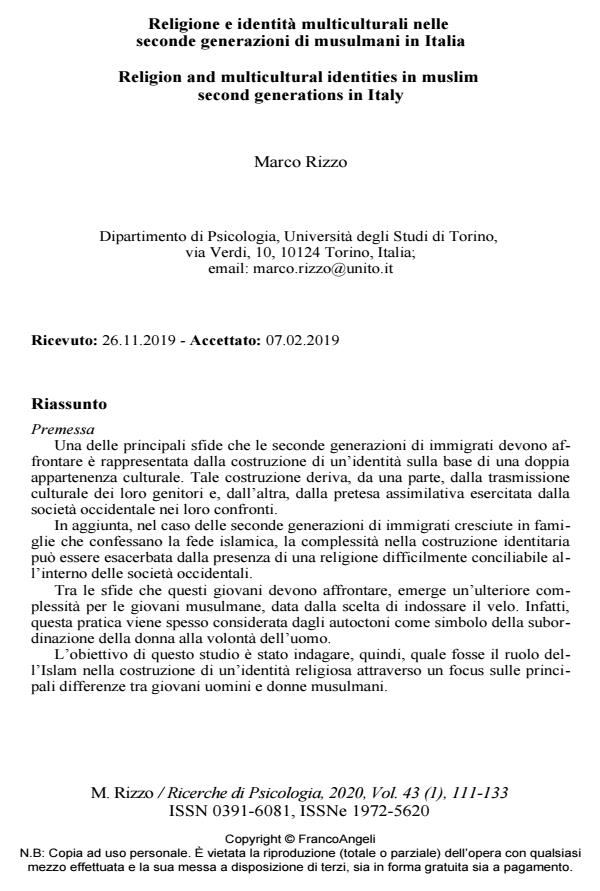Religione e identità multiculturali nelle seconde generazioni di musulmani in Italia
Titolo Rivista RICERCHE DI PSICOLOGIA
Autori/Curatori Marco Rizzo
Anno di pubblicazione 2020 Fascicolo 2020/1
Lingua Italiano Numero pagine 24 P. 111-134 Dimensione file 249 KB
DOI 10.3280/RIP2020-001006
Il DOI è il codice a barre della proprietà intellettuale: per saperne di più
clicca qui
Qui sotto puoi vedere in anteprima la prima pagina di questo articolo.
Se questo articolo ti interessa, lo puoi acquistare (e scaricare in formato pdf) seguendo le facili indicazioni per acquistare il download credit. Acquista Download Credits per scaricare questo Articolo in formato PDF

FrancoAngeli è membro della Publishers International Linking Association, Inc (PILA)associazione indipendente e non profit per facilitare (attraverso i servizi tecnologici implementati da CrossRef.org) l’accesso degli studiosi ai contenuti digitali nelle pubblicazioni professionali e scientifiche
Premessa. Una delle principali sfide che le seconde generazioni di immigrati devono affrontare e rappresentata dalla costruzione di un’identita sulla base di una doppia appartenenza culturale. Tale costruzione deriva, da una parte, dalla trasmissione culturale dei loro genitori e, dall’altra, dalla pretesa assimilativa esercitata dalla societa occidentale nei loro confronti. In aggiunta, nel caso delle seconde generazioni di immigrati cresciute in famiglie che confessano la fede islamica, la complessita nella costruzione identitaria puo essere esacerbata dalla presenza di una religione difficilmente conciliabile all’interno delle societa occidentali. Tra le sfide che questi giovani devono affrontare, emerge un’ulteriore complessita per le giovani musulmane, data dalla scelta di indossare il velo. Infatti, questa pratica viene spesso considerata dagli autoctoni come simbolo della subordinazione della donna alla volonta dell’uomo. L’obiettivo di questo studio e stato indagare, quindi, quale fosse il ruolo dell’Islam nella costruzione di un’identita religiosa attraverso un focus sulle principali differenze tra giovani uomini e donne musulmani. Metodo. In uno studio qualitativo, attraverso interviste semi-strutturate, e stato indagato il ruolo della religione islamica nella costruzione identitaria in un campione di 20 giovani marocchini di seconda generazione (F = 10; eta 18-27; M = 21; DS = 2.3). Le interviste sono state codificate attraverso il software Atlas.Ti. Risultati. I risultati hanno evidenziato una relazione tra il genere degli intervistati e il modo in cui viene vissuta la religione. Per i giovani musulmani l’identita religiosa viene considerata come un aspetto culturale ereditato. Per le giovani musulmane, invece, l’identita religiosa viene concepita come un sostegno per l’affermazione della loro identita multiculturale, principalmente attraverso la scelta libera di indossare il velo.
Parole chiave:Seconda generazione musulmani, Islam, identita, differenza di genere, velo.
- Migrazioni e psicologie. Introduzione al Forum Alessandro Antonietti, Antonella Marchetti, in RICERCHE DI PSICOLOGIA 1/2020 pp.13
DOI: 10.3280/RIP2020-001002
Marco Rizzo, Religione e identità multiculturali nelle seconde generazioni di musulmani in Italia in "RICERCHE DI PSICOLOGIA " 1/2020, pp 111-134, DOI: 10.3280/RIP2020-001006